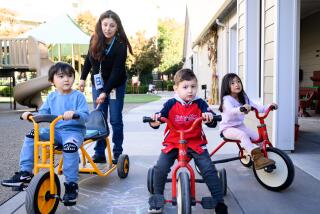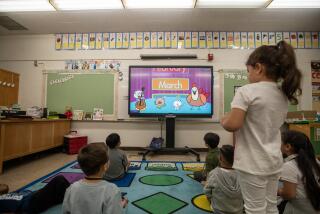Students Use Counseling Skills to Cool Playground Confrontations
- Share via
LANCASTER, Pa. — It sounds, at first, like any other American home--parents arguing, children listening.
But when Bill and Ruth Ann Smith argue, their 11-year-old daughter Cherie no longer just sits back and listens.
“When my mom and dad are arguing, I tell them, ‘I feel mad when you argue because it hurts my feelings.’ Sometimes they listen, sometimes they don’t,” said Cherie.
A mature and mild-mannered sixth-grader at Fulton Elementary School, Cherie is one of the school’s elite--a conflict manager who works as a counselor on the school’s playground.
She has been managing conflicts here since the spring, when the school instituted Mediation in the Schools, a program that teaches children that verbal communication is an alternative to fighting.
Honing Skills
Cherie has been honing her counseling skills on the playground and at home.
“My interest in doing it ties into what we do at the center,” said Sheri Carlyle, executive director of the Lancaster Mediation Center, the organization behind the program.
“We believe there is a positive way to handle conflict. We recognize that conflict is a natural part of life,” she said. “This is the type of program that, at an early age, gets kids realizing that conflict is natural and that there is a better way to handle it than fighting, arguing or going to someone else to make a decision. It empowers kids to take responsibility for themselves.”
Mediation in the Schools was started in the spring as a pilot program by then-Principal David Rentschler. The project worked so well--fights on the playground dropped from between 20 and 25 a week to 4 or 5--that other area elementary schools are becoming interested.
Rentschler, now principal at Burrowes Elementary School, hopes to start the program there soon. Students at Buchanan Elementary School, under Principal Mirianne Herzog, are undergoing the 15-hour training.
The young student counselors--who are fourth-, fifth- and sixth-graders chosen by the school’s students--do not take the place of adult supervisors. Playground aides still man the grounds and the school’s staff still handles serious incidents.
Conflict managers, who range in age from 9 to 12, work in teams of two. Students in conflict are approached by the managers, who have been trained to help their peers work out their problems for themselves.
“The biggest thing I learned is not to solve their problems, but for them to solve it for themselves,” said Cherie.
“We’re not supposed to help them. They’re supposed to do it for themselves because then they learn to solve their problems and we don’t have to help them,” she said.
Conflict managers have been taught the effectiveness of eye contact and have learned how to read eye messages and the feelings of their peers.
“We ask them what the problem is about and then we repeat it back,” said 11-year-old conflict manager Dana Moore. “We say, ‘Do you have a way to solve your problem?’ Sometimes it keeps going back to each other. We don’t suggest things, but sometimes there are solutions.”
Fulton Principal Richard Barbacane says the biggest benefit he has seen is that children are learning to solve their own problems and relying less on playground and lunchroom aides.
The young counselors wear white “Conflict Manager” jerseys when working.
“Instead of things escalating, they defuse things at a much earlier stage,” Barbacane added.
“I like doing it,” 12-year-old Keeshond Cole said. “It cuts down on more fights. More people know about conflict managers . . . and they know if they talk to us, the principal knows about it. Then they stop fighting.”
Report to Principal
After helping their peers resolve their problems, conflict managers complete a report that is given to the principal.
Third-grader Ryan Speidel, 8, said conflict managers really work: When a girl on the playground started fighting with Ryan’s friend, Ryan hit the girl. She quickly sought the expertise of the conflict managers on duty.
“Erin and I talked to the conflict managers. They asked us how we felt and how to not do that again,” he said. “We talked for five or 10 minutes, and then I wasn’t mad. We solved our fight.”
School staffers and Carlyle agree that the program improves conflict managers’ self-esteem. Cherie said her grades had improved since she took the job.
More to Read
Sign up for Essential California
The most important California stories and recommendations in your inbox every morning.
You may occasionally receive promotional content from the Los Angeles Times.












